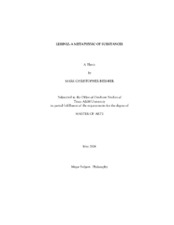| dc.description.abstract | For Leibniz, corporeal substance is the union of body and soul, and he dedicates
much of his thought to understanding the mystery of this union. However, there is a
divide among scholars over what he proposes as a solution. Many have judged that for
Leibniz there are no bodies "out there" in a world independent of the mind. There is, in
fact, no world outside of perceiving things and their appearances. This is taken to imply
that corporeal substances are (at most) the logical relations underlying phenomena; they
would not then be real substances.
Another interpretation is that young Leibniz believes in corporeal substance, but
mature Leibniz recognizes that their reality cannot be maintained. It is in his "later years"
that he finally comes to embrace hard-core phenomenalist commitments, eschewing the
material world as nothing but phantasmagoria. Leibniz has changed his mind, on this
account, and corporeal substances are real only in his "middle years."
I believe that these interpretations are incorrect, and I attempt to show two things.
First, Leibniz holds to real corporeal substances (i.e., they are not merely logical grouping
of monads). Establishing this involves scrutinizing the textual evidence, both for and
against this position. Second, Leibniz has the resources to account for the true unity of corporeal substance. At the heart of Leibniz's metaphysics are the twin themes of unity
and harmony, which permeate every facet of his thought. They are the keys to
understanding what is real, and what is not. A true substance, for Leibniz, is that which
has true unity, and I believe that the unity of a corporeal substance can be explained only
through the harmony of its elements. In short, its harmony is its unity. A third ancillary
point is that corporeal substances are at the heart of his metaphysical system. In the end I
suggest a starting point for a "new system" of interpreting Leibniz's metaphysics. | en |


